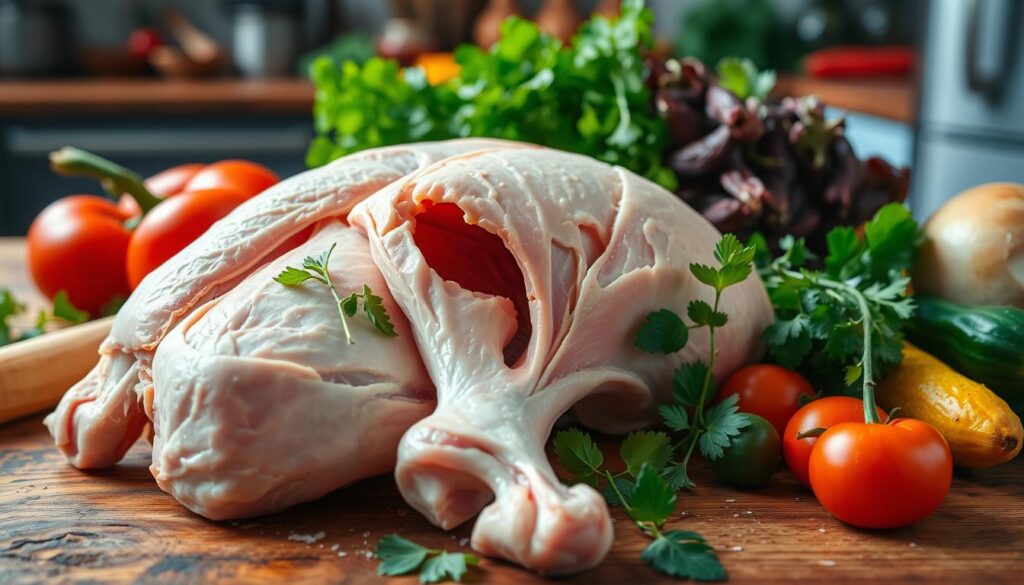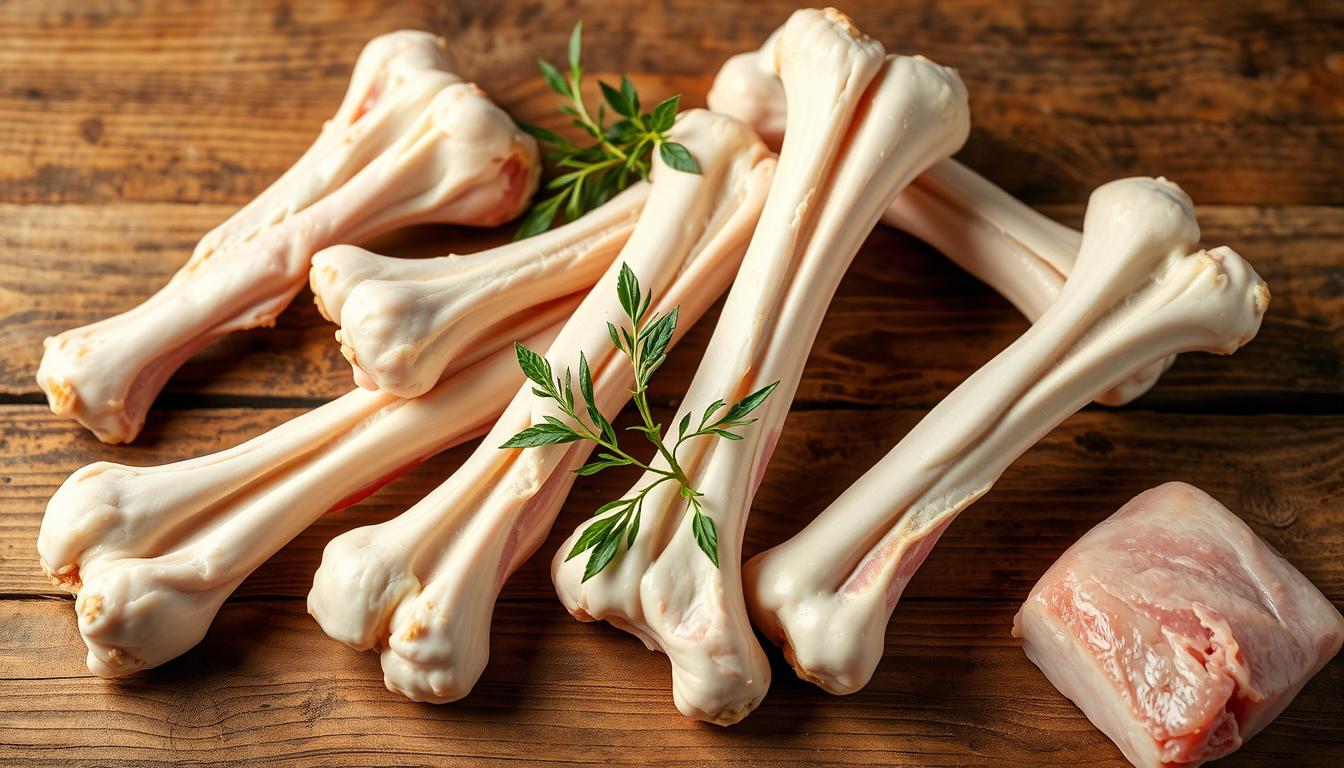As a devoted dog parent, I’ve often wondered about the safety of feeding raw chicken bones to my furry friend. The debate around this topic has left many of us feeling torn. On one hand, dogs have been eating bones for thousands of years. On the other, there are risks of bacterial contamination and choking hazards.
In this guide, we’ll explore the benefits and risks of raw chicken bones for dogs. We’ll also look at the best practices to ensure your dog’s well-being.
Raw chicken bones can be a double-edged sword for our canine companions. They offer nutritional benefits like protein and minerals. But, the risks of feeding them cannot be ignored.
As pet owners, it’s our responsibility to weigh the pros and cons. We must make an informed decision that prioritizes our furry family members’ safety and well-being.
Table of Contents
Understanding Raw Chicken Bones for Dogs
Feeding your dog raw chicken bones can be risky but also has benefits. Raw bones are safer than cooked ones because they don’t splinter as easily. But, there’s a chance of bacterial contamination like Salmonella and E. coli, which can harm your dog and you.
Different Types of Chicken Bones
The safety of chicken bones for dogs depends on the type. Raw chicken necks and wings are safer because they’re mostly cartilage and soft bones. These are less likely to cause harm if swallowed. But, bigger bones like thighs and drumsticks can splinter and cause internal damage.
Raw vs. Cooked Comparison
Cooked chicken bones are fragile and can break into sharp pieces. This can lead to serious health issues like internal bleeding or intestinal obstruction. Raw chicken bones are safer because they’re more flexible and less likely to splinter. But, it’s crucial to consider your dog’s size and breed, as smaller dogs might risk fracturing their teeth while chewing.
| Characteristic | Raw Chicken Bones | Cooked Chicken Bones |
|---|---|---|
| Splintering Risk | Lower | Higher |
| Dental Risks | Potentially higher for small breeds | Lower |
| Bacterial Contamination | Higher | Lower |
| Digestive Risks | Moderate | Higher |
When deciding on raw chicken bones for your dog, consider the risks and benefits. Make a choice that fits your dog’s needs and characteristics.
Can Dogs Eat Raw Chicken Bones: Essential Facts
Dogs can eat raw chicken bones, but it’s important to be careful. Raw bones are softer and less likely to splinter than cooked ones. Still, there are risks to think about when giving them to your dog.
Raw chicken bones offer nutrients like calcium and phosphorus. They also help keep teeth clean by removing plaque and tartar. Chewing on them can also keep your dog’s mind active and happy.
- Over 20 years of advocating raw feeding at Nurturing by Nature
- Birds processed for human consumption are usually 5-6 weeks old, leading to softer bones
- Cooking chicken bones makes them brittle and prone to splintering
But, there are dangers too. Raw chicken can have Salmonella or Campylobacter, which can make dogs very sick. There’s also a chance of choking or stomach problems if the bones are too big or not chewed right.
Start with small, safe bones and watch your dog closely. Think about your dog’s size and how they chew. Always talk to your vet before changing your dog’s diet.
Feeding raw chicken bones to your dog needs careful thought. Know the good and bad to keep your dog safe and healthy.
The Natural Diet Perspective
Dogs have eaten bones for thousands of years. Wild canines, like wolves, eat bones as part of their prey. They also eat raw meat, organs, and bones. But, domestic dogs have changed a lot since they started living with humans.
Some say raw bones are good for dogs because they’re like their ancestors’ diet. But, others worry that domestic dogs might not be able to handle raw bones as well as wild ones.
Historical Context of Dogs and Bones
Dogs and bones go way back in history. Wolves, the ancestors of modern dogs, ate whole prey, including bones. This shows that dogs might be able to digest and benefit from raw bones.
Wild Canine Feeding Patterns
In the wild, canines like wolves and coyotes mostly eat raw meat, organs, and bones. This diet gives them important nutrients like calcium and phosphorus. It helps them stay healthy. Knowing how wild canines eat can help us understand the good and bad of raw bones for domestic dogs.
Potential Health Benefits of Raw Chicken Bones
Raw chicken bones can be great for your dog’s health. They are full of calcium, phosphorus, and protein. These nutrients are key for your dog’s well-being.
Chewing on these bones helps keep your dog’s teeth clean. It reduces plaque and tartar. It also strengthens their gums and satisfies their natural urge to chew.
Raw chicken, especially the breast, is high in protein and low in fat. It’s a good addition to your dog’s diet. But remember, bones alone can’t give all the nutrients your dog needs. They should be part of a balanced diet.
| Nutrient | Quantity in Raw Chicken Bones |
|---|---|
| Calcium | 22% of daily requirement |
| Phosphorus | 18% of daily requirement |
| Protein | 53% of daily requirement |
The benefits of raw chicken bones for dogs are clear. But it’s important to handle and store them safely. This prevents bacterial contamination and health risks. Talk to your vet about adding raw chicken bones to your dog’s diet. Consider their size, breed, and needs.

Safety Risks and Health Concerns
Feeding raw chicken bones to dogs can have benefits, but there are risks. Bacteria like Salmonella, E. coli, and Campylobacter can cause food poisoning. This is a big health risk for dogs and their owners.
Choking is another serious risk. This is especially true for smaller bones or dogs that swallow their food quickly.
Raw chicken bones can also cause digestive problems. Sharp bone pieces can hurt a dog’s insides, like causing blockages or holes. Puppies and small dogs are more likely to get hurt because of their size and sensitive stomachs.
Bacterial Contamination Risks
Raw chicken bones can have harmful bacteria. Dogs and their owners can get very sick from these bacteria. It’s important to handle and store raw chicken bones carefully to avoid contamination.
Choking Hazards
Raw chicken bones can be a choking hazard for dogs. Small bones or bones swallowed quickly can get stuck in a dog’s throat. This can cause serious breathing problems and even be life-threatening. Owners should watch their dogs closely when giving them raw bones and make sure the bones fit their dog’s size.
Digestive Issues
Even though raw chicken bones are softer than cooked bones, they can still hurt a dog’s insides. Sharp pieces can cause serious damage, like bleeding or blockages. Owners should watch for signs of stomach problems after their dog eats raw chicken bones.
Knowing the risks of feeding raw chicken bones to dogs helps owners make better choices. It’s important to handle and store bones safely and choose the right bones for their dogs. This way, owners can enjoy the benefits of this natural treat while keeping their dogs safe.
Signs of Complications After Bone Consumption
If your dog has eaten chicken bones, watch them closely for any signs of trouble. Look out for vomiting, being very tired, constipation, or seeing blood in their stool. These could mean they’re having problems.
Also, keep an eye out for a lot of drooling, coughing, gagging, or trouble breathing. This might mean a bone is stuck in their throat or airway. Signs like belly pain, not wanting to eat, and being restless could also point to internal issues.
Usually, chicken bones will break down in a dog’s stomach acid in 24-48 hours. But, it’s possible for exceptions, so keep a close eye. If you see any of these symptoms, get your dog to the vet right away. They might need urgent care.
The size of your dog and how many bones they ate can affect the risks. A bigger dog eating a few small bones might be okay. But a smaller dog eating more bones might need vet help.
After eating chicken bones, dogs often need fluids to stay hydrated. They might get fluids through an IV for 24 hours. They might also get special diets and probiotics to help their stomach and gut heal.

Feeding bones to dogs can be risky, and vets have different opinions. Some say no bones are safe, while others think raw bones of the right size and shape might be okay. But, if your dog eats a chicken bone, call the vet right away. This depends on your dog’s size, the bones they ate, and any signs of distress.
Proper Storage and Handling Guidelines
Storing and handling raw chicken bones for dogs is key to keep your pet safe. It’s important to store them at the right temperature and follow safe handling practices. This helps prevent harmful bacteria from growing.
Temperature Requirements
Raw chicken bones need to be stored in the fridge at 40°F (4°C) or colder. If you freeze them, thaw them in the fridge, not at room temperature. This stops harmful bacteria like Salmonella and Listeria from growing.
Use thawed bones within 24 hours. Discard any leftovers in 12 hours.
Storage Duration Guidelines
- Frozen raw chicken bones can last up to 6 months in the freezer.
- Refrigerated bones should be used in 3-5 days after thawing.
- Freezing bones for 3 weeks before feeding can reduce bacterial risk.
Always wash your hands and clean surfaces after handling raw chicken bones. This prevents the spread of foodborne illnesses. By following these safe handling tips, you can keep your dog healthy and safe when giving them raw chicken bones.
Size and Breed Considerations
Feeding raw chicken bones to dogs depends on their size and breed. Larger dogs can handle bigger bones, but smaller dogs and puppies are at risk. They might choke or get hurt in their digestive tract.
Bones should be longer than a dog’s muzzle to prevent choking. They should also be big enough not to fit through the dog’s throat. Always watch your dog when they eat bones, no matter their size or breed.
- Chicken bones can dissolve in a dog’s stomach but still cause problems. They can splinter, cause bleeding, and block the intestines.
- Puppies are more likely to have problems because their stomachs are smaller.
- Raw chicken bones are easier to get stuck in a dog’s mouth than cooked bones.
Even though bigger dogs can eat larger bones, it’s important to watch how they chew and swallow. Smaller dogs and puppies need extra care when it comes to appropriate bone size for dogs and breed-specific considerations for raw bones.
When deciding if to feed raw chicken bones, consider your dog’s size and breed. It’s crucial to supervise and monitor them closely to keep them safe.
Veterinary Perspectives on Raw Bones
Vets have different views on giving dogs raw chicken bones. Some see benefits like better dental health and more nutrients. But others worry about bacteria, choking, and stomach problems.
Professional Recommendations
Many vets say to talk to a pro before adding raw bones to a dog’s diet. They stress knowing the dog’s health and needs is key. Also, handling and storing raw bones safely is very important.
Current Research Findings
The raw diet for dogs, including bones, is popular but research is still out. Vets say we need more studies to fully understand its effects. They recommend being careful and watching for any bad reactions in dogs.
To learn more about the benefits and risks of feeding raw bones to dogs, talk to your vet and keep up with new research.

